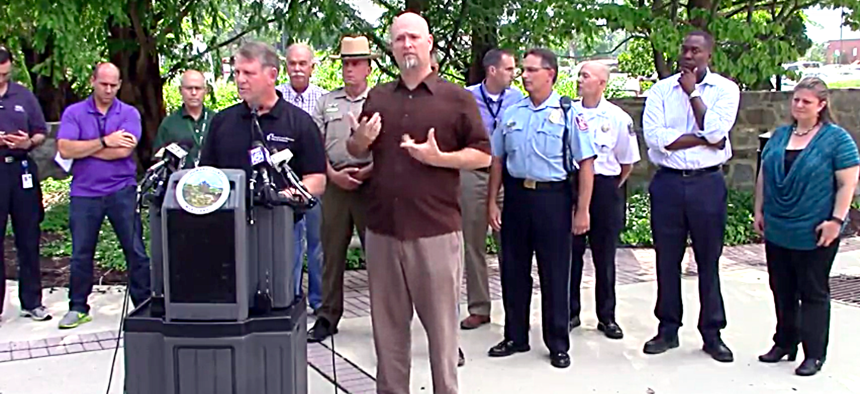Flash Floods Turn Maryland Town’s Main Street Into River

Howard County Executive Allan Kittleman speaks during a news conference on Sunday afternoon. Howard County Maryland / YouTube
Historic Ellicott City, near Baltimore, is no stranger to flooding, but with Saturday’s rains amounting to a once-in-1,000 year storm, the rising waters took many by surprise.
Historic Main Street in Ellicott City, Maryland, turned into a raging torrent on Saturday night when creeks that converge on downtown jumped their banks in flash flooding, destroying homes and small businesses.
Two people, a pedestrian and a motorist, were confirmed dead in the flooding, the result of six and a half inches of rain that had fallen over the course of two hours. Video captured dramatic scenes during the flooding, including a human chain being used to rescue a motorist .
The town, the seat of Howard County, is 12 miles west of downtown Baltimore and was founded in the 1770s. In 1830, Ellicott City became the first western terminus of the Baltimore & Ohio Railroad—one of the nation’s earliest railroads. It’s home to the nation’s oldest surviving railroad station , now part of the B&O Museum, which draws tourists, along with antique shops, restaurants and other small businesses.
Considering its constrained topography, Ellicott City is, unfortunately, no stranger to flooding. But Howard County Executive Allan Kittleman said that the force of the water on Saturday was far stronger than the floods from Hurricane Agnes in 1972, according to WBAL-TV .
"I was here for [Hurricane] Agnes. I was 14 years old. I remember it,” Kittleman said. “You know, it was a lot of water and it was a lot of mud, but it didn't have the force as this storm."
On Saturday, the level of the Patapsco River rose 14 feet in the course of 90 minutes.
A flood in 1868 killed 43 people in Ellicott City. A National Weather Service hydrologist told The Baltimore Sun that Saturday’s rains amounted to a once-in-a-1,000-years storm .
Kittleman declared a state of emergency for his county, as did Maryland Gov. Larry Hogan .
Bob Frances, director of the Howard County Department of Inspections, Licenses and Permits, said during a news conference that of 200 buildings surveyed along Main Street, four or five “will be classified as destroyed” and 20 to 30 received “significant” damage.
Floodwaters undermined portions of the street and sidewalk and a water main was ruptured, officials said during a news conference.

The next immediate task is debris removal, including towing about 170 cars from the downtown area and in the Patapsco River. Kittleman urged people to steer clear of the impacted area so the immediate response operations can continue.
Then the difficult work of recovery will continue.
RELATED on Route Fifty : “ Why Elected Officials Sometimes Need to Rein In Their Influence During Emergencies ”
Michael Grass is Executive Editor of Government Executive’s Route Fifty and is based in Seattle.
NEXT STORY: It’s Time for Regional Primaries






